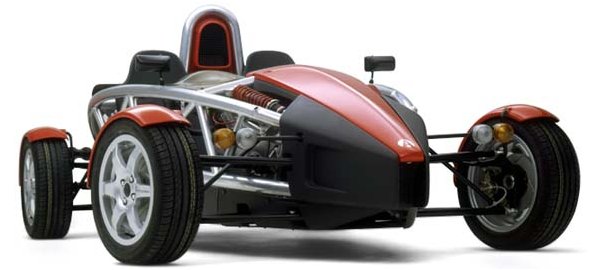A lone Ariel Atom sits at the starting line of Silverstone Circuit, its exposed frame gleaming under the morning sun. The absence of traditional bodywork reveals every component, each purposefully positioned for maximum performance. This isn’t just another sports car — it’s a testament to automotive minimalism that changed performance car design forever.
In 2001, while mainstream manufacturers were adding layers of complexity to their sports cars, Ariel Motors took a radically different approach. They stripped away everything non-essential, creating a vehicle that would redefine the relationship between driver and machine.
Engineering Brilliance: The Art of Reduction
The Ariel Atom’s engineering excellence lies not in what was added, but in what was removed. At its heart beats a Honda-sourced supercharged four-cylinder engine, chosen for its exceptional power density and reliability. Every component serves a direct purpose, contributing to the car’s remarkable power-to-weight ratio that surpassed even the Chevrolet Corvette of its time.
The chassis design represents a masterclass in structural engineering. Each tube in the frame serves multiple purposes: structural rigidity, safety, and aerodynamic flow management. The result is a vehicle that weighs significantly less than conventional sports cars while maintaining exceptional torsional stiffness.
«The Atom’s structural design is pure efficiency in motion,» says Marcus Reynolds, chief instructor at Silverstone Racing Academy. «Every tube, every joint has been optimized for both strength and weight. It’s like looking at a Formula 1 car stripped to its essentials.»
The suspension system, featuring double wishbones at all four corners, delivers precise feedback and exceptional control. This direct connection between driver and road creates an experience that’s both challenging and rewarding.
Fact!
The Ariel Atom's frame contains over 40 meters of precision-welded steel tubing, each section carefully designed to provide maximum structural integrity while maintaining minimal weight.
Design Philosophy: Form Following Function
The Atom’s design philosophy transcends conventional automotive aesthetics. Its exposed framework isn’t just a visual statement — it’s an engineering solution that optimizes weight distribution and aerodynamic efficiency. The absence of bodywork allows for better heat dissipation and reduces weight while creating unique aerodynamic properties.
Key design elements that demonstrate this approach include:
- integrated roll cage structure that provides safety while defining the car’s form;
- exposed suspension components that allow for quick adjustments and maintenance;
- minimalist cockpit that focuses solely on essential controls and information;
- aerodynamic elements integrated into the structural framework;
- modular design allowing for easy component upgrades and modifications.
«When we first saw the Atom, many thought it was unfinished,» recalls Sarah Chen, automotive design consultant. «But its ‘unfinished’ state is precisely what makes it perfect. Every element you see is there because it needs to be there.»
Important!
The Atom's design influenced a generation of track-focused vehicles, proving that lightweight construction and minimal complexity could deliver superior performance.
Track Performance: Raw Speed Unleashed
On the track, the Atom reveals its true character. The combination of lightweight construction and powerful engine creates acceleration that rivals supercars costing many times more. The direct steering and responsive chassis deliver an unfiltered driving experience that many modern sports cars have lost in pursuit of comfort.
The supercharged engine provides immediate response, with power delivery that’s both linear and predictable. Track testing revealed acceleration figures that seemed almost impossible for a car of its era.
«It’s the closest thing to driving a formula car on the street,» states James Harrison, professional racing driver. «The level of feedback and control is simply extraordinary. You don’t just drive an Atom — you wear it.»
The car’s handling characteristics set new standards for track-day vehicles. Its low weight and optimized suspension geometry create a level of agility that makes conventional sports cars feel cumbersome in comparison.
Legacy and Impact
The Atom’s influence extends far beyond its own production numbers. Its success proved that radical minimalism could deliver exceptional performance, inspiring numerous track-focused vehicles that followed. Modern lightweight sports cars, from the BAC Mono to various track-day specials, owe a debt to the path blazed by the Atom.
This approach to performance car design has influenced even mainstream manufacturers, who increasingly emphasize weight reduction and mechanical purity in their track-focused models. The Atom demonstrated that less could indeed be more in the pursuit of performance.
Historical Reference!
The Atom's appearance on Top Gear, where it famously distorted Jeremy Clarkson's face due to its acceleration, became one of the most iconic moments in automotive television history.
The car’s impact on automotive culture continues to resonate, inspiring a new generation of engineers and designers to question conventional wisdom about what makes a performance car.
A Blueprint for the Future
Twenty-four years after its introduction, the Atom’s philosophy remains remarkably relevant. As the automotive industry grapples with increasing complexity and weight, the Atom’s minimalist approach offers valuable lessons about efficiency and purposeful design.
The principles that made the Atom revolutionary — minimal weight, maximum efficiency, and direct driver engagement — are increasingly important in an era of electric powertrains and autonomous technology. Its legacy proves that sometimes the boldest step forward is removing what isn’t necessary.
Pros and Cons
| Advantages | Disadvantages |
|---|---|
| Exceptional power-to-weight ratio delivering supercar-level performance | Limited weather protection due to minimal bodywork |
| Unmatched driver feedback and engagement | Restricted practical usability for daily driving |
| Outstanding track capability and handling | Minimal storage space |
| Easy maintenance access to all components | Limited comfort features |
| Excellent modification potential | Not suitable for long-distance travel |
| Superior aerodynamic efficiency | Exposed to elements while driving |
| Track-ready from the factory | Limited passenger protection in adverse conditions |
The Ariel Atom 2001 represents a pivotal moment in automotive history where conventional wisdom was successfully challenged. While it may not be the most practical daily driver, its influence on performance car design and engineering cannot be overstated. The Atom proves that when it comes to pure driving excitement and performance, sometimes less is dramatically more.

